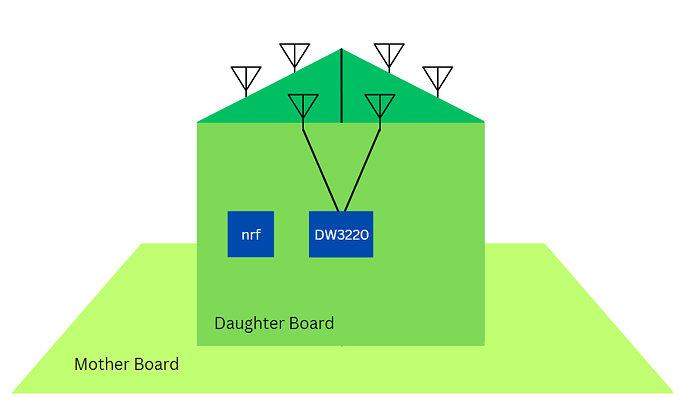Can I use 3 - 4 DWM3001C as a anchor? The reason is that I want it to be able to scan 360 degree using PDoA. And I want to use one DWM3001C as a tag. The system may contain 10 anchors and 50 tags in a 50m^2 area. Is it possible?
Hey, that depends on the situation you want to use the system in. For example, how often do you want your tags to be updated? Of course this setup is possible, but you’d need 2 DWM3001C for a TDoA setup, as the receive time difference is meassured between those two modules. For every dimension you want to meassure on (given you have n dimensions), you would need at least (n+1) * 2 modules for the system to work. Let’s take the 2 dimensional space for example: You would need at least (2+1)*2 = 6 modules for it to work, arranged in groups of 2.
Be aware tho, that the TDoA scheme works quite different to a Two-Way-Ranging system, because you can’t apply the third dimension into your scheme as easy as with Two-Way-Ranging (correct me if I’m wrong on this one ![]() )
)
In your case, suggesting that you would use the 10 anchors you specified, that would be 5 groups which should be sufficient enough to locate a tag.
You would need to somehow synchronize the sending time of the data frames of the tags, just as a reminder.
Hope this helps
Philipp
Thank you for your response. Instead of TDoA, I was considering using PDoA. My goal is to use one anchor to locate multiple tags in the current stage and possibly more anchors in the future. I came across a paper that suggested it is possible to perform all directional PDoA using only four sensors(if I understand it correctly). I am wondering if the DWM3001C is capable of this and if the same formula can be used for calculating the location of multiple tags.
DW3001C have only 1 RF port. So this not based on Aoa chip. You need QM33120 which is an Aoa chip.
@wlph17 I recommend you check out this post for more information on the differences of PDoA and TDoA: Two ranging or TDOA or PDOA - #4 by AndyA
Regarding the paper, you’d probably have to dig in deeply to fully understand how it works. As wassim said, the DW3001C has only one antenna port, making it impossible to use PDoA with just one chip.
If you want to skip the evaluation board and make your own pcbs, the DW3120 or DW3220 (just differentiate in the package type) might be worth a shot, or even the new DW3300Q ![]()
@Wassim_Qorvo @Fhilb Thank you so much.
I think my design for the anchor is somewhat like this, each daughter should be able to scan around 150 degree 2d area.
If I am using two DWM3001C for the daughter board:
- I have to deal with clock synchronization and communication delay which I have to code
- It is easier to design the pcb
If I am using DW3220 for the daughter board:
- DW3220 should be able to get me a PDoA result by using the SDK
- It is harder to design the pcb
am I understand this correctly?
That is about right. Although the DW3220 PCB should be about the same difficulty to design.
e.g. in the PCB design software “EasyEDA” there is already a DW3220 model included as part of their parts library. So you’d basically just have to route the whole thing and connect it to your nrf board.
You could use the standard 0.1 inch pin headers for that purpose as well.
Personally, I would use a DWM3001C board to get the basic transmission to work before scrambling with the hardware, and then design your own DW3220 board. With this approach, you can be sure that your code works on a solid and proven hardware and then check your own designed piece of hardware against that working code.
Fhilb
